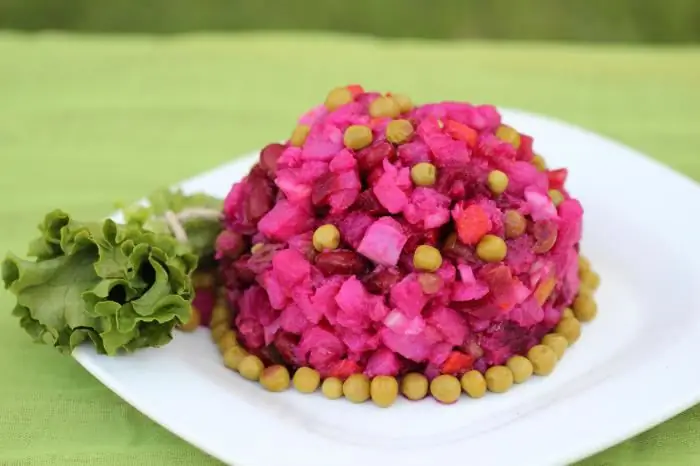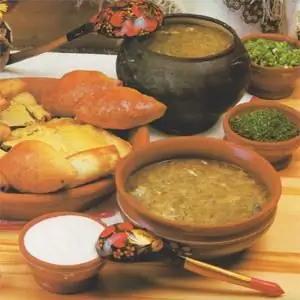2026 Author: Isabella Gilson | [email protected]. Last modified: 2025-01-23 12:50:30
There are a lot of features in Russian cuisine, as in any other. It is famous for a wide variety of dishes that are simply impossible to find somewhere abroad. Of course, before Russian cuisine was not so popular, because the food was too simple. Everything changed, and religious fasts could not but influence the appearance of a variety of dishes.
Features of Russian Orthodox cuisine

Fasting did not allow people to eat certain types of food, so it took a lot of contriving. There were many dishes from vegetables, mushrooms and fish. All products could be stewed, boiled or baked - in general, they did everything to diversify the limited diet a little. Despite the fact that Russian cuisine did not abound with chicken or other meat products, many Europeans were still interested in certain dishes because they were really tasty.
After a while, Russia itself had its own cookbook where you could see everythingfeatures of Russian cuisine.
Soups
Speaking of primordially Russian dishes, it is difficult not to take into account the soups and stews that were eaten by both peasants and intellectuals. This food was prepared on the basis of everything: kvass, curdled milk, meat broths. Of course, cabbage soup, hodgepodge, rassolnik are also well-known "advanced" dishes of Russian cuisine. Today, they can be found on many restaurant menus and abroad.
Porridge
A feature of Russian cuisine is also porridge. It is a basic dish in the diet of every Russian. They love, for example, buckwheat, oatmeal and millet porridge, which are often eaten without additives. Now there are variations like oatmeal with raisins, buckwheat with meat, herbs or sour cream.
Porridge was not only consumed daily, it was a table decoration. For example, on Christmas holidays it is customary to eat kutya. When they meet a newborn child at home, they put "Grandma's" porridge on the table.
There were times when bread was substituted for this dish, so it is not surprising that many Russians eat the same cabbage soup with barley or other porridge. Probably, it was this mass prevalence that helped porridge become a feature of the national cuisine of Russian people.
Meat
The meat of cows, calves, pigs, rabbits, elks and many birds is an undoubted feature of Russian cuisine. There are many recipes with which you can cook whole meat, in pieces, make minced meat from meat, and then cutlets. In Russia, they did not ignore the offal of animals, making them the main component of many soups, snacks, and individualdishes in principle.
For example, the well-known beef tongue, which was boiled and served with various side dishes. It's rare to find food like this. The peculiarity of cooking dishes in Russian cuisine from meat is that the product can become a component of a completely unusual meal. For example, when they make a cow's udder with vegetables or stuff a piglet with buckwheat and apples. For every taste and color!
Dumplings

Of course, many people know that the birthplace of dumplings is the Urals. Pelmeni are somewhat similar to khinkali or manti, but they have a different shape, as well as a variety of fillings. A product in the form of a bear's ear can be filled not only with meat or fish, it can be made from meat with pumpkin, beets, greens.
Side dishes and sauces

In Russia, they also like to serve dishes with various side dishes to make them even tastier. Potatoes were most often used for this, sauerkraut, fresh and stewed beets, and carrots were also loved.
Fat sour cream was used for sauces, which could be seasoned with garlic or horseradish, as well as herbs. If the sauces were made hot, then they were served with the dish, as they were added during cooking. Berries, saffron, onions were taken as a basis.
Pickles
Pickles and sour products were made before and are being made now. It is difficult to imagine any Russian table without such a dish. For example, they often cooked sauerkraut, pickled mushrooms or cucumbers, pickled tomatoes.
Baking

In Russia, pastries were especially revered. They prepared kulebyaki, pies, pies, kurniki and cheesecakes. Some dishes were used as bread, so they were eaten with soups or cereals. Sweet pastries were left for dessert when it was tea time.
Alcohol
Of course, as without alcohol, because abroad they only say that vodka is a Russian drink. Yes, this drink is Russian and was created by Dmitri Mendeleev. A feature of Russian cuisine is also the presence of vodka on the table. Caviar or pickles are used as snacks, and some people like to eat very fatty foods.
What did Russians drink before vodka? Medovukha or sbiten! These drinks were very popular throughout Russia. Also in some regions they made beer on a different basis. The Russians did not ignore the fermented kvass either, as it was, in fact, somewhat reminiscent of beer.
Many people liked to pamper themselves with wine drinks that appeared in Russia at the moment when Christianity was adopted. It is for this reason that at first wine was not so common and loved by people, but then everything changed.
Recommended:
A dish that is called Russian all over the world. Dishes of Russian cuisine

Once upon a time, the inhabitants of Europe were practically not interested in the traditions of Russian cuisine, due to the low sophistication of its dishes. However, this pretentious attitude did not play a significant role and, on the contrary, served as a motivating mechanism for the emergence of new recipes
Types of coffee drinks and their features

Many types of coffee drinks will allow almost everyone to find their favorite variety and enjoy it. In order not to study the menu for too long, having come to the institution, we suggest that you figure out right now how different coffee can be
Traditional Bulgarian cuisine: dishes and their features

Traditional Bulgarian cuisine is distinguished by a variety of flavors that can conquer the heart and stomach of even the most spoiled tourist. The peculiarities of national dishes are a pronounced taste, the presence of a large number of seasonings and spices and a lot of greens, vegetables and cheeses of our own production
Russian folk dishes: names, recipes, photos. Folk dishes of the Russian people

Russian food, and this is no secret to anyone, has gained immense popularity around the world for a long time. Whether this happened due to the mass emigration of citizens of the Russian Empire to many foreign countries with subsequent integration into the culture of these peoples (including the culinary one). Whether it happened even earlier, in the time of Peter, when some Europeans "felt", so to speak, Russian folk dishes with their own stomach
Belarusian national cuisine: the most popular dishes and recipes for their preparation

Belarusian national cuisine is famous for its rich menu, which includes hearty and rather simple dishes. Despite the fact that it was formed on the basis of Russian, Ukrainian, Lithuanian and Polish culinary traditions, it has many unique soups, salads and other treats that have no analogues in any world cuisine

